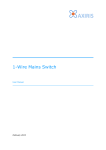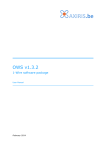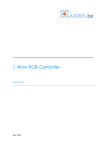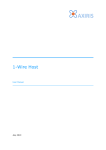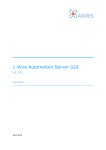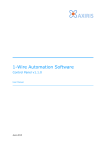Download 1-Wire Relay Card User Manual
Transcript
1-Wire Relay Card User Manual February 2015 1-Wire Relay Card Table of Contents 1 Features 3 2 Technical Specifications 3 3 1-Wire Relay Card Board Overview 1-Wire Terminal Block Connector (K3) 1-Wire RJ45 Connectors (K4, K5) 1-Wire Slave Chip Power Selection (JP1) Power Connector (K1) Power Connector (K2) Relay Contacts (K6, K7, K8, K9) Digital Inputs 1-Wire Connectivity Communications Protocol 4 4 5 5 5 6 6 6 7 7 8 4 Software Support 1-Wire Automation Server ows owfs 10 10 10 11 5 Legal Information Disclaimer Trademarks 12 12 12 6 Contact Information 12 Revision History Date Authors Description 2013-07-28 Peter S'heeren Initial release. 2015-02-17 Peter S'heeren Added section about 1-Wire Automation Server software support. Second release. 2 User Manual 1-Wire Relay Card 1 Features ▪ 4 relay outputs capable of switching 4 A at 230 V AC. ▪ 4 opto-isolated digital inputs 5-30 V DC 10 mA max. ▪ Power supply 12 V DC 200 mA max. ▪ Power connection via coaxial DC plug or screw terminals. ▪ 1-Wire interface is galvanically isolated from the main power supply to avoid ground loops. ▪ 1-Wire connections via standardized RJ45 jacks or screw terminals. ▪ The 1-Wire slave chip can be powered parasitically, using an external 5 V line or using the on-board 5V supply. 2 Technical Specifications Weight 98 g Dimensions 117 mm x 86 mm x 19 mm (W x D x H) User Manual 3 1-Wire Relay Card 3 1-Wire Relay Card Board Overview 1 2 3 4 5 6 7 Mark Label 1 K3 1-Wire bus terminal block connector 2 JP1 Power selection 3 K6, K7, K8, K9 Relay contacts 4 K5 1-Wire bus RJ45 connector 5 K4 1-Wire bus RJ45 connector 6 K1 12V power supply 7 K2 12V power supply 8 4 8 Description Digital inputs User Manual 1-Wire Relay Card 1-Wire Terminal Block Connector (K3) Mark Description GND Ground 1W 1-Wire DQ line (data) 5V 5 V supply GND 1W 5V 1-Wire RJ45 Connectors (K4, K5) Mark Description 1 Unassigned 2 +5 V power 3 Unassigned 4 1-Wire DQ (data) 5 1-Wire ground 6 Unassigned 7 Unassigned 8 Unassigned 1 2 3 4 5 6 7 8 1 2 3 4 5 6 7 8 Plug top view Receptacle front view All eight pins are routed between the two connectors. The relay card doesn't use the unassigned lines. 1-Wire Slave Chip Power Selection (JP1) Mark Description 1 Parasitic power 2 External power 3 Power derived from 12V 1 2 3 This jumper determines how the 1-Wire slave chip is powered: ▪ Parasitic power: the 1-Wire slave uses an internal capacitor as its power source. The capacitor is charged during idle time (DQ line held high) and provides power during bus activity. The 5 V line (K3, K4, K5) is not applicable. ▪ External power: the 1-Wire slave draws power from the 5V line. Be sure the voltage is provided to one of the 1-Wire connection points (K3, K4, K5). ▪ Power derived from 12 V: The 5 V for the 1-wire slave chip is derived from the 12 V power supply (K1 or K2). See the 1-Wire specification for more information about parasitic power. User Manual 5 1-Wire Relay Card Power Connector (K1) Mark Description 12V 12 V input GND Ground 12V GND If you connect the 12 V power source to this connector then you must not connect a 12 V power source to K2. The corresponding pins of K1 and K2 are interconnected. Power Connector (K2) Polarity If you connect the 12 V power source to this connector then you must not connect a 12 V power source to K1. Relay Contacts (K6, K7, K8, K9) COM Mark Description COM Common contact NO NO Normally open contact These connectors are wired to the contacts of the relays. Each relay can switch at most 4 A at 230 V AC. 6 User Manual 1-Wire Relay Card Digital Inputs Mark Description 1 Input 1 2 Input 2 3 Input 3 4 Input 4 GND1 Ground GND2 Ground 1 2 3 4 GND1 GND2 GND1 and GND2 are interconnected. The max. values for each input are 5-30 V DC 10 mA. 1-Wire Connectivity The relay card provides three connection points for 1-Wire cabling and wiring. 5V 1W GND The terminal block connector is typically used for wiring the relay card to an AbioWire or another 1-Wire adapter. Terminal block connector K3 The RJ45 receptacles provide a means to set up a 1-Wire bus in daisy chain using UTP cables. K4 RJ45 receptacle K5 RJ45 receptacle 1 User Manual 2 3 4 5 6 7 8 7 1-Wire Relay Card Communications Protocol The 1-Wire slave function on the relay card is a Maxim DS2408 chip. See the Maxim DS2408 datasheet for more information about the 1-Wire slave chip. The family code of the DS2408 is 29h. Since the family code alone doesn't uniquely identify a 1-Wire Relay Card device, the host system must associate the full 8-byte ROM code with the device. The host system is expected to use Standard speed when communicating with the relay card over the 1-Wire bus. PIO channels 1-4 of the DS2408 use negative logic to control the relays. To turn on a relay, write zero to the corresponding PIO channel. To turn off a relay, write one to the corresponding PIO channel. PIO channels 5-8 are connected to the input terminals. You must always program these PIO channels as logic one. 8 User Manual 1-Wire Relay Card The following diagram shows how to write byte value F6h to the relay card. The following diagram shows how to read the PIO logic states, PIO output latches and PIO activity latches from the relay card. start start 1-Wire Reset 1-Wire Reset 1-Wire Write Byte 1-Wire Write Byte 55h (match ROM) 55h (match ROM) 1-Wire Write Bytes 1-Wire Write Bytes 29h xxh xxh xxh xxh xxh xxh xxh 29h xxh xxh xxh xxh xxh xxh xxh 1-Wire Write Bytes 1-Wire Write Bytes 5Ah F6h 09h F0h 88h 00h 1-Wire Read Byte 1-Wire Read Bytes result xxh xxh xxh result equals AAh? stop Y stop User Manual N error 9 1-Wire Relay Card 4 Software Support 1-Wire Automation Server Use client command Device PIO to control the state of the relays. For example: dev "29-11BD2A" pio off 1 4 on 2 This command turns on relays 1 and 4 and turns off relay 2. To determine the state of the inputs, issue client command Device Sense: dev "29-11BD2A" sense force dev "29-11BD2A" sensed ds2408 "2015-02-15 10:10:20 11110010 11110010 10001111 reset external" The most significant four bits of the sensed values (marked in yellow) represent the state of the inputs. The 1-Wire Automation Server GUI program offers a comfortable way to work with the 1Wire Relay Card in a graphical desktop environment: In the above picture, the first relay has been turned on and all four inputs are high. ows Software package ows v1.3.0 and later includes program owspio. This program enables you to fully control the relay card. Example invocations of the program: # ./owspio -lu -id 29-11BD2A -off 1 4 -on 2 This command turns on relays 1 and 4 and turns off relay 2. # ./owspio -lu -id 29-11BD2A -read 10 This command reads the state of the four relays and the sensed state of the four inputs ten times. 10 User Manual 1-Wire Relay Card owfs It's assumed you're using the filesystem client of the owfs package. In the examples it's supposed you've specified /mnt/onewire/ as the mount directory for the 1-Wire file system. Since owfs inverts all values written to PIO channels, the default negative logic becomes positive logic. # echo "1" > /mnt/onewire/29.2ABD11000000/PIO.0 This command turns on relay 1. Note the use of positive logic as opposed to the real value zero that's written to the PIO latch in the DS2438. # echo "0" > /mnt/onewire/29.2ABD11000000/PIO.3 This command turns off relay 4. # cat /mnt/onewire/29.2ABD11000000/PIO.0 This command reads the latched value for relay 1. # cat /mnt/onewire/29.2ABD11000000/sensed.0 This command reads the sensed value of relay 1. # cat /mnt/onewire/29.2ABD11000000/sensed.4 This command reads the sensed value of input 1 on the relay card. # cat /mnt/onewire/29.2ABD11000000/sensed.7 This command reads the sensed value of input 4 on the relay card. User Manual 11 1-Wire Relay Card 5 Legal Information Disclaimer Axiris products are not designed, authorized or warranted to be suitable for use in space, nautical, space, military, medical, life-critical or safety-critical devices or equipment. Axiris products are not designed, authorized or warranted to be suitable for use in applications where failure or malfunction of an Axiris product can result in personal injury, death, property damage or environmental damage. Axiris accepts no liability for inclusion or use of Axiris products in such applications and such inclusion or use is at the customer's own risk. Should the customer use Axiris products for such application, the customer shall indemnify and hold Axiris harmless against all claims and damages. Trademarks All product names, brands, and trademarks mentioned in this document are the property of their respective owners. 6 Contact Information Official website: http://www.axiris.eu/ 12 User Manual












